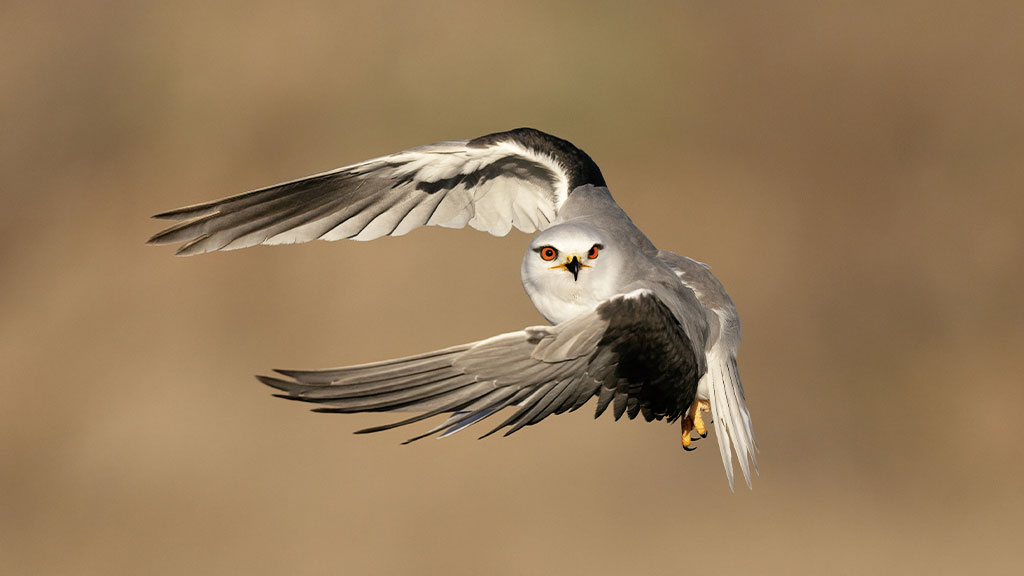Diary of a swan spotter
Volunteer swan spotter extraordinaire, Wim Tijsen, talks Bewick’s, climate change and why the calls of the swans’ post migration reunions are forever etched into his memory.
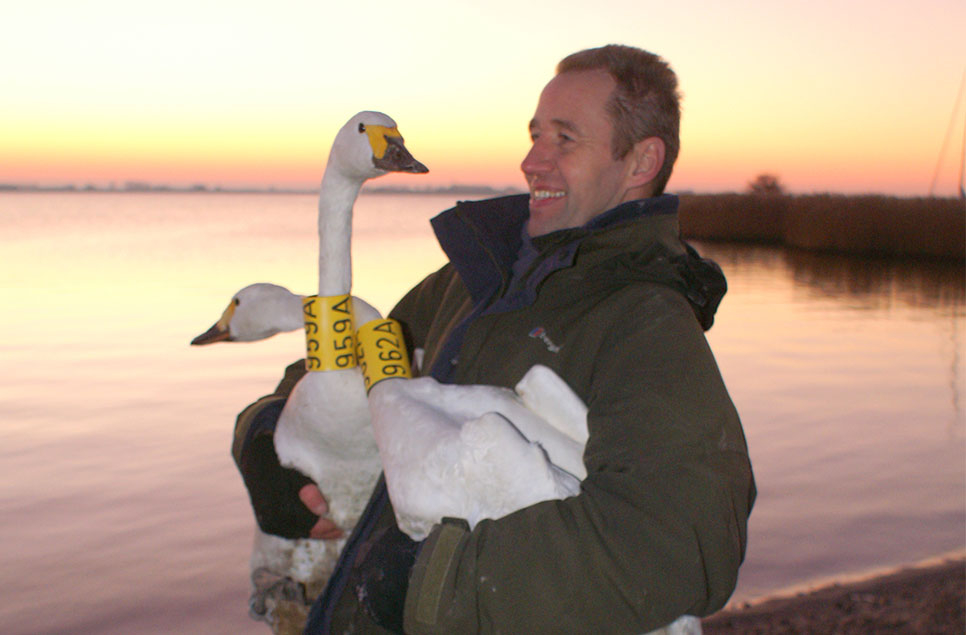
As spring arrives across northern Europe, it’s coaxing the Bewick’s swans ever eastwards towards their summer breeding grounds in the Russian arctic. And as they leave their winter foraging grounds on their epic migration, all along their flyway volunteer ring readers like Wim Tijsen will be turning out to record the birds, building up a picture over decades that’s helping inform the conservation of this threatened swan.
I first got into spotting Bewick’s in the late 70s when I was a boy of 18. I grew up on a farm in the Netherlands and I remember there was this one really cold harsh winter. We’d never seen swans on our land before. But that winter they decided to visit our polder (a kind of wetland) for the first time. I remember wondering about these mysterious visitors which had travelled all the way from Russia. I wanted to find out everything I could about them.
My enthusiasm grew in the 80’s when they started doing ‘brood counts’ in my area. I started getting involved counting how many cygnets each pair of Bewick’s had so we could work out the average number per pair and see how successful they had been at breeding that year. Then, when they started ringing the birds I got a telescope and that opened up a whole new world for me. I could read the bird’s uniquely coded leg ring, register the sighting and then receive information all about that bird - its whole life, where it had been on migration, did it have a mate or any cygnets? Now I’m in charge of co-ordinating these brood counts that take place every year in December, across the whole of North West Europe.
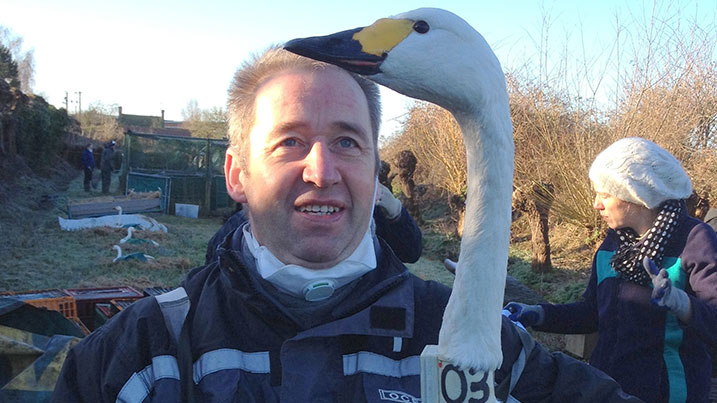
It’s easy to predict the day the swans will first start arriving. Towards the end of October, I start watching the weather forecasts for Estonia, Lithuania and Germany every day because that’s where they’ll be coming from. The swans will already have completed the first stage of their migration, flying from Russia to Estonia and Lithuania. They’ll then be there for up to a month, waiting for the right weather conditions to make the final stage of their journey. You’re looking for clear skies with a cold north east tail wind.
A typical swan spotting day starts early. Swans often fly overnight and arrive early morning. I get so anxious about missing their arrival that I’m already on the road as the sun’s coming up, driving the 100km to the nearest lake where I’m likely to see them. It’s become a real passion of mine and I try to visit the lakes or arable areas they use as many weekends as possible during the winter.
The most exciting thing is hearing the calls of the first arrivals as they come into land on the lakes. It’s etched into my memory. Bewick’s mate for life and undertake their epic migrations together. Usually they arrive in groups of 30 to 50. But sometimes they become separated. So, when they arrive, the first thing they do is call out to locate their mate. For me it’s so haunting and melancholy, the sound of the swans calling out for each other across the water as they re-unite after their epic journey. Sometimes it can take them a couple of hours to find each other. It’s always been about that sound and wondering what stories they could tell. I remember many days full of that sound on Lake Lauwersmeer.
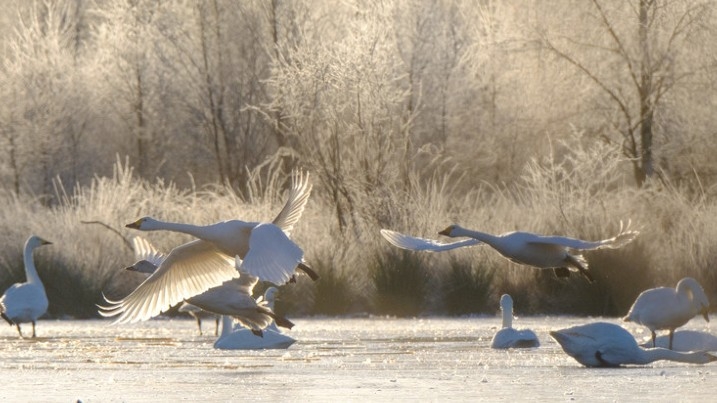
The most important quality you need to be a swan spotter is patience. When I first started, the swans only had leg rings, so you had to be very patient and wait for them to upend in the water to feed, so you could see their legs. You have to be within 400 metres to be able to read the leg rings. Now some of the Bewick’s have neck collars so that makes it easier to identify them, from up to 1 kilometre away. You have to be good at handling the telescope. It’s definitely easier on a still day. Mostly I know from experience where to find the swans because generally they’ll use the shallower parts of the lake, so I set myself up by the reed beds. At the beginning of the season they’ll be a bit nervous, having spent the summer on the remote arctic tundra, but as the season continues you can get closer to them. I’m usually about 200m away.
There’s always a favourite that drives you out of bed early on a cold winter morning to see if they’ve arrived safely. If a bird is ringed, it becomes like a personal friend because you see it every year for ten years or more and you get to know its life story. There was one bird that was ringed in Martin Mere in 1991 that I became particularly attached to. XNY was a beautiful strong female.
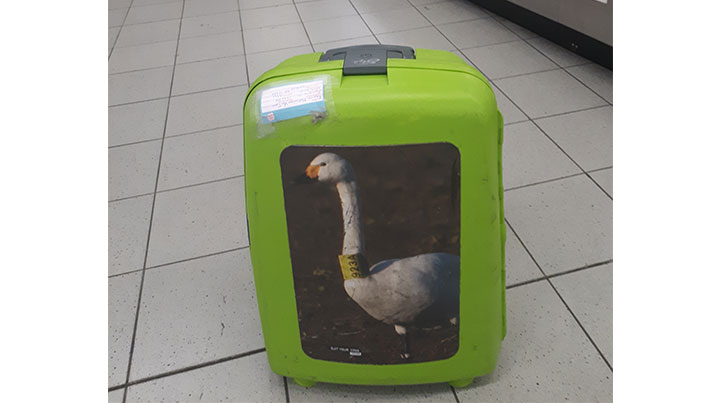
I’d been following her almost all my adult life and had spotted her many times. She was a very successful bird. She’d been spotted in Ireland, had a partner and together they’d had lots of cygnets over the years. As a couple they were a dominant pairing in the flock. But then her partner died, and it was like she lost her zest for life. She stopped migrating to the UK. She lost her social status and I’d often see her on the edge of the flock. Over the years I saw her condition deteriorate. Then one day I was giving a presentation about Bewick’s and one of my colleagues handed me a swan ring. It read XNY. I had to fight back tears. The bird that had been dearer to me than any other, had died. She’d been attacked by a fox and her ring had been handed in after her body had been discovered. I now carry that ring with me wherever I go attached to my binoculars.
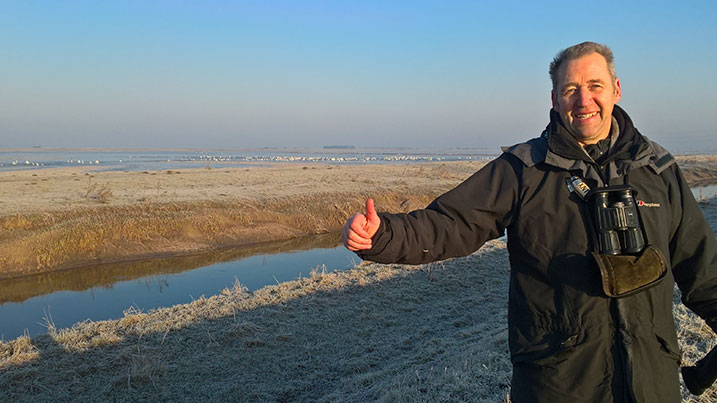
I’ve made some amazing friendships with people from countries all along the swans’ flyway through my volunteer work. Most of the time I’m on my own when I’m out spotting swans, but sometimes I go with friends and when my sons were younger, my wife and I used to take them with us, just pack some cookies and milk in the car. And when visiting friends or family, there was always a good reason to pass a flock of swans somewhere in the neighbourhood on our way… It’s definitely become a family affair.
Over the years I’ve seen a lot of changes. I remember there used to be so many swans arriving in the first wave, it would take me a whole weekend to identify all the swans. But the Bewick’s population has suffered a steep decline, dropping by a third in recent years to fewer than 20,000. Illegal hunting, lead poisoning, wetland habitat loss and predation all play a part.
Climate change has also had an impact, affecting their migration pattern. Because of the work of volunteer ring readers like me, we know that the birds are now wintering further east. Twenty-five years ago, you would have found one third of the population overwintering in the UK at places like Slimbridge and Welney and two thirds would have been in the Netherlands and Germany. But now, because winters aren’t as cold, there’s no need for them to fly so far west to escape the weather. Now you’ll find maybe 50% in Germany, over 10% in Poland, 5% in Denmark, 30% in the Netherlands and only 5% make it as far as the UK. So, in my area of the Netherlands, we don’t see so many Bewick’s in the winter nowadays.
I did a research project in my free time on the swans on my local polder. I discovered that there’s been a change in their feeding habits. When their population was at their highest, you would find the swans spreading out from the water and foraging on the sugar beet tops in local fields. But now as the population has shrunk, there’s less pressure to find food, so they feed more on the water in the Netherlands.
I started visiting WWT Welney for my annual swan holiday about 25 years ago. I wanted to see where the swans I ringed in the Netherlands went to. There was one time I had parked up on the side of the road near some wet grassland area close to Amsterdam and I spotted a ringed pair in the distance. After getting permission from the farmer and crawling through ditches in the wet and cold I finally got close enough to read the rings – TUB and TUA. After putting that much effort into reading a ring, you get a connection and you want to know what happens to that swan. So imagine my delight when a few months later when I was nearly at the end of my annual swan holiday in Welney I spotted the same ringed pair on the Ouse Washes amongst a group of 800 birds!
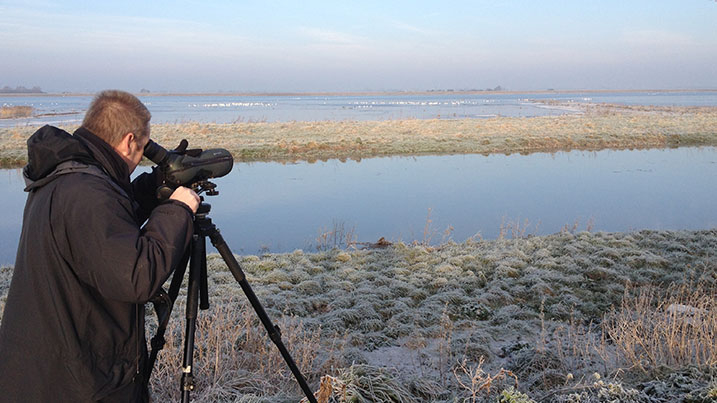
I was invited for tea by Lady Scott. During our visits to Welney my friend Henk Schobben and I discovered that the Bewick’s had been wintering not just on the Ouse Washes, but also on the reservoirs nearby, so there were in fact more swans wintering in that area than previously thought. Lady Scott invited us to Slimbridge to hear more about this discovery and it was wonderful to sit in the same living room where Sir Peter Scott first started identifying the individual swans by their bill patterns all those years ago.
My reward is knowing that I’m providing vital information that’s helping inform how we can help protect these wonderful birds. Bewick’s swans face challenges to their survival all along their migratory route. I would urge anyone considering becoming a swan ring reader to realise how valuable this work is. And because our work is done over decades it can provide vital information for conservationists on the changes that are happening, how they affect the birds and what needs to be done to protect them.
All photos are the property of Wim Tijsen
Find out more about Bewick's swans
Bewick’s swans have fascinating lives. Find out more about the Bewick's swan, where it lives and the threats it faces.
